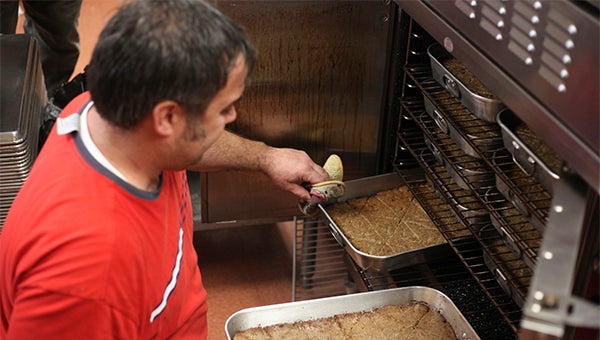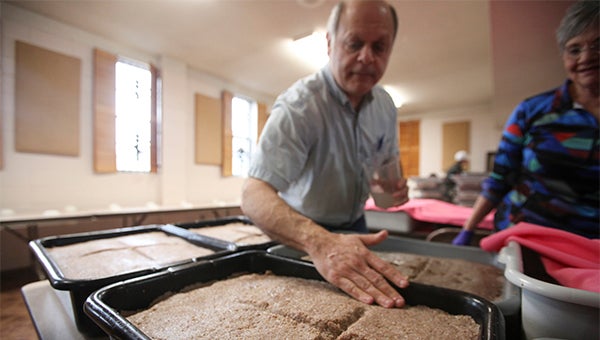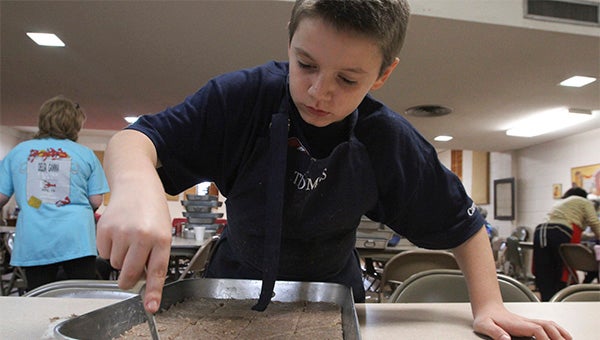St. George orthodox church keep Lebanese culture alive in Vicksburg with annual feast
Published 10:56 am Wednesday, March 7, 2018
As the smells of the food that define his culture wafted down the hall, Gregory Thomas was brought to tears by the memories passed down from his grandfather.
The scent of onions, cinnamon and cracked wheat intermixed with the sounds of multiple generations working together to prepare the kibbee that is a mainstay in any Lebanese household.
Sitting in a room in his church, Thomas’ voice cracked and tears began to flow at the thought of how far his family had come.
“All of my grandparents were from Lebanon,” Thomas said. “They were searching for a better life. They were starving to death. My grandfather has told me tons of stories. One in particular, not long before they were able to save a little money to leave from Beirut, he went seven days without eating. He told me, he said, ‘Gregory, we ate grass. That was all I had.’ I will never forget those stories.”
Each year the congregation at St. George Orthodox Church in Vicksburg come to together to prepare their culture’s dishes for thousands of people during the annual Lebanese dinner.
The church was founded in 1906 after the original members arrived in Vicksburg from Syria and Lebanon. They brought with them their culture and food as they searched for a better home. This year the church shared that food with the Vicksburg community during the 58th annual Lebanese dinner.
“Part of the reason I brought my kids up here and working in this church is they did it for us and we have to let that legacy live on,” Thomas said. “It makes me very proud that they were sharing. When they started that, people didn’t know what Lebanese food was. A lot of people would ask even when I was a kid, ‘Are you Christian?’ It is nice to pass that on and it is nice to share that with the people here.”
Lebanese food is “not fancy, but it is very hearty” Mary Louise Nosser said. The main seasonings are salt, pepper and cinnamon, with lamb and seafood serving as the main meats in the dishes.
“They eat lamb and goat because Lebanon is a very mountainous country and we don’t have room for cows,” Nosser said. “We can’t graze the cattle, but the goats and sheep can climb up all over those mountains. They are very much at home there, but they don’t eat a lot of meat.”
Cracked wheat, made by soaking ground wheat called bulgar in water, and olive oil are mainstays in Lebanese dishes, as are lemon juice and garlic. The recipes have helped keep the culture alive in Vicksburg as they have been passed from generation to generation even as the Lebanese in Vicksburg have intermarried and left few full-blooded Lebanese in the area.
“I taught my kids in person and over the phone,” Mary Rantisi, a member of St. George who is originally from Syria, said. “They were busy with high school and college and then my oldest got married and moved away to Texas. I actually went over the recipes and how to cook over the phone with her and she is an excellent cook. The middle one, she had it in her blood. I didn’t have to teach her much. The youngest one is getting it.”
The process has gotten easier over the years as kitchen machines have expedited the process. While the scents of the food and the community it builds have remained the same, Maha Habeeb, who moved to Vicksburg from Lebanon 40 years ago, said the sound of the kibbee being made that was a constant companion during her childhood has disappeared.
“Long ago, I remember my grandmother and mother mashing it and (what they use) is made out of stone and the one you mash with is made out of wood,” Habeeb said. “They mash the meat and it is a hard thing to do. On Sunday morning, all you hear around the village is everybody making kibbee. They are loud because of the noise from the home. In the Lebanese community, once they came here they started making Lebanese food and mainly kibbee.”
The numbers at the church have shrunk in recent years, but through the food they are working to make sure the next generation remembers how far their ancestors came to build a life here and make sure the culture continues to prosper.
“I would say it is the number one importance because that is what brings you home,” Nosser said. “That is what reminds you of home. Even in the grocery store if they buy a piece of baklawa, you are there for a few minutes you are at mama’s table.”
chickpea dip -hoomus b’tahini
Ingredients
42 cans chickpeas (garbanzos)
42 large garlic cloves, crushed
46T Tahini
41T Olive oil
42t Salt
4Juice of 4 lemons (more or less as desired)
4½ to 1C of water
Instructions
Rinse chickpeas in cold water. Into a blender or food processor, put rinsed garbanzos, crushed garlic, oil, salt and lemon juice. Blend well. If needed, slowly add water until the mixture is the consistency of a heavy cake batter. Store in refrigerator.
Hoomus B’Tahini is delicious served at room temperature with Arabic bread.
stuffed yellow squash – mishee-koosa
Ingredients
418 to 24 medium yellow squash, cored
42 (6 oz) Can tomato sauce or paste
41 Can beef broth (optional)
41 ½c Long grain rice
42 lbs. Ground beef (chili grind)
41 ¼ T salt
4¼ Stick softened butter
4½t Black pepper
4½t Cinnamon
4Salt, black pepper, red pepper and cinnamon to taste
Instructions
For filling: Combine rice, beef, one can of tomato paste and salt, black pepper, red pepper and cinnamon to taste
Wash squash well; slice off neck. Core squash, leaving about 1/4-inch shell. Rinse and drain well. Stuff each loosely with filling. Place necks of squash in bottom of large pot and add stuff squash to pot.
In another container, mix one can of tomato paste, beef broth and seasonings; pour over squash. Add enough water to pot to just cover. Bring to a hard boil for a few minutes; lower heat to simmer. Cover and cook until done, about 45 minutes.
Variation: Eggplant, bell pepper, zucchini or tomatoes can be substituted for yellow squash. Delicious topped with laban (yogurt).
Pita bread – ka maaj
Ingredients
48C Flour
43T Sugar
42T Salt
42 pkg. Dry yeast
42C Warm water
41C Milk
4½C Oil
Instructions
In a bowl, dissolve yeast and sugar in warm water. With fingers, blend flour and salt. Add yeast mixture and liquid and work dough with hands until it is no longer sticky, adding additional water if needed. Add oil and knead until dough is smooth. Transfer dough to a greased bowl and grease surface of dough. Cover and let stand in a warm place until double (about 1 hour).
Make 12 to 14 parts the size of an orange. With floured hands, work pieces into very smooth balls. Place on floured surface; cover and let rest for 1 hour. Using fingers or a rolling pin, roll each ball into a 6 or 7 inch circle, being careful not to stretch or crease dough.
Gently place 2 circles on an ungreased hot cookie sheet. Bake in a preheated 450 degree oven for 10 minutes or until dough is puffed and amber color. Repeat, baking one batch at a time. Use the same hot ungreased cookie sheet again. Remove from oven and rub oil completely over hot bread. Makes 12 to 14 loaves.
basic kibbee
Ingredients
42 ½C Cracked wheat (bulgur)
42 lbs. Lean finely ground lamb or beef
42 large onions, finely grated or ground
41T Salt
41t Black pepper
4½t Red pepper
4¼t Cinnamon
Instructions
Prepare wheat according to preceding directions. Place all ingredients in a large mixing bowl. Mix well in a kneading fashion, folding over frequently and gently squeezing through fingers. While doing this, keep hands wet and cool by dipping often into bowl of ice water. Finished kibbee will have a raw meatloaf-like appearance.
All kibbee recipes, raw or cooked, can be frozen.
Method of Preparing Cracked Wheat (Bulgur) for Recipes:
Rinse wheat in a bowl of water several times. Cover with 3 cups of water for each cup of wheat. Soak for 30 minutes. Drain well though a fine strainer. Return to bowl one handful at a time, squeezing forcefully so that all excess water is removed.
Note — Bulgur is packed in 3 different ways:
1. Fine grind (No. 1 wheat).
2. Coarse grind (No. 2 wheat).
3. Mixed grind (No. 3 wheat).
As desired, any grind can be used for the recipes using cracked wheat (bulgur).
cabbage rolls – mishee malfoof
Ingredients
For filling:
42 medium or 1 large head cabbage, parboiled and prepared
41 lbs. Ground beef or lamb*
42C Rice
41C Butter, melted
4Salt, pepper and cinnamon to taste (be generous)
Seasonings for water:
46 Garlic cloves, quartered
4½ to ¾C Lemon juice
4Salt, pepper and cinnamon to taste
Instructions
To prepare filling, add butter and seasonings to rice; mix well. Add meat. Mix by squeezing until meat and seasoned rice are “bound.” Set aside.
To roll cabbage leaves, evenly distribute 1 to 1½ tablespoons of filling along the edge of the leaf. Roll firmly, cigar fashion, leaving end open.
Line bottom of large pot with heavy outer leaves. Add 8 pieces of garlic. Lay rolls side by side. When first layer is completed, lay rolls in an opposite direction; continue alternating each layer. Lay heavy leaves on top. Add seasoned water to cover. Place inverted plate over leaves. Cook, covered, on medium heat for 20 minutes. Add lemon juice. Cook 10 to 15 additional minutes until done.
Note: Can be cooked in an oven. Put rolls into a deep casserole in the same alternating layer method. Add the seasoned water. Cook at 450 degrees until water comes to a boil. Decrease heat to 350 degrees. Cook until done, about 30 minutes.
Add lemon juice in final 15 minutes of cooking.
How to prepare cabbage leaves for rolling:
To parboil cabbage, remove the core and place cabbage, core end down, into boiling water. With a long fork and/or tongs, remove leaves from head of cabbages as they loosen. Allow leaves to remain in the water, cooking until tender, 3 to 5 minutes. Remove, drain, and cool. Parboiled cabbage leaves must then have the hard stem cut out. Large leaves and cut into halves.
*One can chickpeas (garbanzos) can be substituted for one pound meat.
baklawa
Ingredients
41 lbs. Fillo pastry sheets
44C Clarified butter, melted
41 ½ lbs. Nut filling
41 ½C Heavy syrup
Note — Before preparing baklawa, carefully read and follow the complete directions on the box of fillo pastry sheets.
Instructions
Method of Preparing Heavy Syrup and Nut Filling:
Basic Heavy Syrup
42 C sugar
41 C water
41T lemon juice
In a heavy saucepan, slowly bring sugar and water to a boil. Simmer for 10 minutes. Remove from heat and add lemon juice. Store in refrigerator.
Basic Nut Filling
41 lb. nuts, coarsely ground
4¼ to ¾ c. sugar (optional)
Pecans or walnuts can be used, either alone or in any desired proportion. Sugar may be mixed with the nuts if desired.
Grease a 12x15x2 inch pan with butter. Carefully separate fillo sheets and lay one sheet at a time in buttered pan. Using a pastry brush or small paint brush (reserved for this purpose), brush each sheet with butter. Continue until 10 pastry sheets have been used. Spread nut filling evenly over the pastry, then place the remaining fillo sheets, one by one, brushing each with butter, until all have been used. Brush the top.
Using a sharp knife, cut into 2-inch squares and loosen from the sides. Preheat oven to 350 degrees. Bake 55 to 60 minutes or until lightly golden and crisp. Remove from oven and immediately pour syrup over baklawa. Allow to completely cool in the pan before removing. This well glazed pastry should be stored in an airtight container. Baklawa freezes well.










